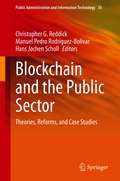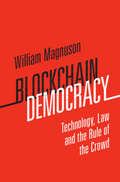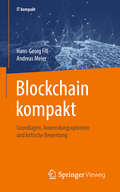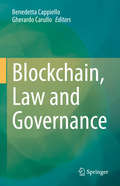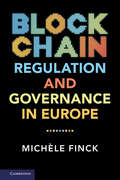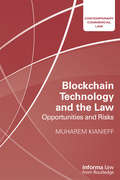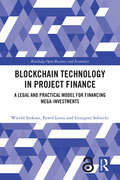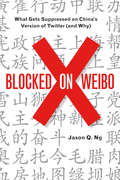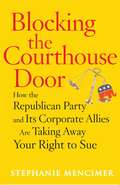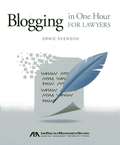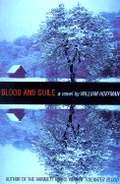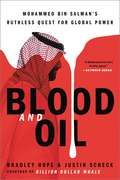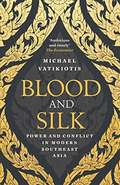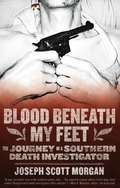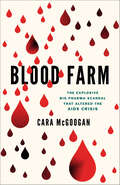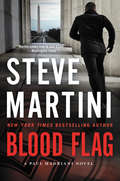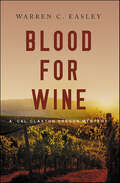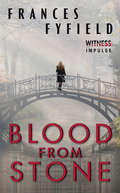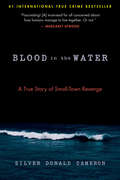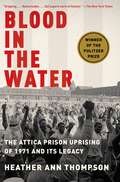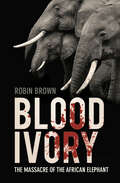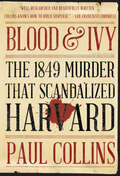- Table View
- List View
Blockchain and the Public Sector: Theories, Reforms, and Case Studies (Public Administration and Information Technology #36)
by Christopher G. Reddick Manuel Pedro Rodríguez-Bolívar Hans Jochen SchollThis book discusses blockchain technology and its potential applications in digital government and the public sector. With its robust infrastructure and append-only record system, blockchain technology is being increasingly employed in the public sector, specifically where trustworthiness and security are of importance. Written by leading scholars and practitioners, this edited volume presents challenges, benefits, regulations, frameworks, taxonomies, and applications of blockchain technology in the public domain.Specifically, the book analyzes the implementation of blockchain technologies in the public sector and the potential reforms it would bring. It discusses emerging technologies and their role in the implementation of blockchain technologies in the public sector. The book details the role of blockchain in the creation of public value in the delivery of public sector services. The book analyzes effects, impacts, and outcomes from the implementation of blockchain technologies in the public sector in select case studies.Providing up-to-date information on important developments regarding blockchain in government around the world, this volume will appeal to academics, researchers, policy-makers, public managers, international organizations, and technical experts looking to understand how blockchain can enhance public service delivery.
Blockchain Democracy: Technology, Law and the Rule of the Crowd
by William MagnusonIn Blockchain Democracy, William Magnuson provides a breathtaking tour of the world of blockchain and bitcoin, from their origins in the online scribblings of a shadowy figure named Satoshi Nakamoto, to their furious rise and dramatic crash in the 2010s, to their ignominious connections to the dark web and online crime. Magnuson argues that blockchain's popularity stands as a testament both to the depth of distrust of government today, and also to the fervent and undying belief that technology and the world of cyberspace can provide an answer. He demonstrates how blockchain's failings provide broader lessons about what happens when technology runs up against the stubborn realities of law, markets, and human nature. This book should be read by anyone interested in understanding how technology is changing our democracy, and how democracy is changing our technology.
Blockchain kompakt: Grundlagen, Anwendungsoptionen und kritische Bewertung (IT kompakt)
by Hans-Georg Fill Andreas MeierLernen Sie in diesem Fachbuch mehr über die Grundlagen von BlockchainSie interessieren sich für Kryptowährungen durch Blockchain-Technologie? Aber irgendwie erscheint Ihnen die Thematik wie ein Buch mit sieben Siegeln? Dieses Fachbuch von Hans-Georg Fill und Andreas Meier liefert Ihnen einen Überblick rund um Blockchain. Es erläutert detailliert und übersichtlich die Grundlagen zu folgenden Themenfeldern:Datenstrukturen wie Hash-Funktionen und -BäumeDigitale SignaturFunktionenKonsensalgorithmenetc.Blockchains sind jedoch nicht nur ein Teil von Kryptowährungen. Es handelt sich um ein digitales Buchungssystem. Die Technologie von Ethereum ist daher für viele Unternehmen äußerst interessant (Stichwort Smart Contracts, Smart Grid, Smart Cities). Das Fachbuch über Blockchain ist somit genau das Richtige für Sie, wenn Sie Verbesserungen im eigenen Unternehmen, der Verwaltung oder im öffentlichen Leben vornehmen oder alternative Lösungen angehen wollen.Konzepte und Anwendungen der KryptographieIn den sechs Kapiteln des Fachbuches über Blockchain liefern Ihnen die Autoren Antworten auf verschiedene rechtliche Fragen. Sie befassen sich im Rahmen ihrer Ausführungen kritisch mit der Blockchain-Technologie und zeigen Ihnen wichtige Anwendungsoptionen. Sie erhalten einen fundierten Überblick über folgende Themenfelder:Motivation Betrugsprävention Grundlagen zur Blockchain-Technologie Aufbau und Funktion der BlockchainAnwendungsoptionen Rechtliche FragenKritische EinschätzungDieses Fachbuch über Blockchain richtet sich an Führungsverantwortliche, Projektleiter und Interessierte, die sich einen Überblick über das Potenzial der Blockchain-Technologie verschaffen möchten.
Blockchain, Law and Governance
by Benedetta Cappiello Gherardo CarulloThis volume explores from a legal perspective, how blockchain works. Perhaps more than ever before, this new technology requires us to take a multidisciplinary approach. The contributing authors, which include distinguished academics, public officials from important national authorities, and market operators, discuss and demonstrate how this technology can be a driver of innovation and yield positive effects in our societies, legal systems and economic/financial system. In particular, they present critical analyses of the potential benefits and legal risks of distributed ledger technology, while also assessing the opportunities offered by blockchain, and possible modes of regulating it. Accordingly, the discussions chiefly focus on the law and governance of blockchain, and thus on the paradigm shift that this technology can bring about.
Blockchain Regulation and Governance in Europe
by Michèle FinckIn Blockchain Regulation and Governance in Europe, Michèle Finck examines the relationship between blockchain technology and EU law and introduces the theme of blockchain governance. The book provides a general introduction to blockchains as both a regulatable and a regulatory technology and outlines the interaction between distributed ledger technology and specific areas of EU law, such as the General Data Protection Regulation. It should be read by anyone interested in EU law, the relationship between law, innovation and technology, and technology governance.
Blockchain Technology and the Law: Opportunities and Risks (Contemporary Commercial Law)
by Muharem KianieffBlockchain Technology and the Law: Opportunities and Risks is one of the first texts to offer a critical analysis of Blockchain and the legal and economic challenges faced by this new technology. This book will offer those who are unfamiliar with Blockchain an introduction as to how the technology works and will demonstrate how a legal framework that governs it can be used to ensure that it can be successfully deployed. Discussions included in this book: - an introduction to smart contracts, and their potential, from a commercial and consumer law perspective, to change the nature of transactions between parties; - the impact that Blockchain has already had on financial services, and the possible consumer risks and macro-economic issues that may arise in the future; - the challenges that are facing global securities regulators with the development of Initial Coin Offerings and the ongoing risks that they pose to the investing public; - the risk of significant privacy breaches due to the online public nature of Blockchain; and - the future of Blockchain technology. Of interest to academics, policy-makers, technology developers and legal practitioners, this book will provide a thorough examination of Blockchain technology in relation to the law from a comparative perspective with a focus on the United Kingdom, Canada and the United States.
Blockchain Technology in Project Finance: A Legal and Practical Model for Financing Mega-Investments (Routledge Open Business and Economics)
by Witold Srokosz Paweł Lenio Grzegorz SobieckiThere is currently no comprehensive scientific study that addresses the problem of financing projects using Distributed Ledger (blockchain) Technology (DLT) that are not themselves embedded in the blockchain ecosystem, particularly in the context of long-term and capital-intensive investments. This book fills this gap. It poses a number of research questions such as what financing model/mechanism is the most effective in the long term where very large financial resources are concerned; are there appropriate legal regulations in place; and can DLT (blockchain) technology provide usability and solutions that can be used in the process of financing capital-intensive investments?The book ultimately shows that it is possible to build a legal and economic model that would effectively enable the financing of long-term and capital-intensive investments, based on a specially prepared integrated platform operating on the basis of blockchain technology. As a result of the mechanisms of smart contracts, the platform would enable, the issuance and service of tokens, including equity tokens, but also auxiliary and payment or utility tokens, and the automation of relations between stakeholders. It would also allow the creation of a virtual decentralized autonomous organization (DAO) that would control the implementation of the project, and a decentralized exchange that would enable token trading.The core readership for the book is academics, scholars and researchers in the fields of economics, finance and law, particularly those focused on blockchain technology, distributed ledger systems, and innovative financing mechanisms for large-scale investments. Policymakers and regulators involved in developing policies and legal frameworks for blockchain technology, cryptocurrencies, and financial innovation would find it to be a practical reference.
Blockchain und maschinelles Lernen: Wie das maschinelle Lernen und die Distributed-Ledger-Technologie voneinander profitieren
by Sigurd Schacht Carsten LanquillonDurch Bitcoin wurde die Blockchain als zugrundeliegende Technologie bekannt. Sie zählt zu den Distributed-Ledger-Technologien, die zukünftig viele Bereiche des wirtschaftlichen Handels beeinflussen werden. So bergen dezentrale autonome Anwendungen enormes Potenzial, nicht nur Prozesse, sondern auch Vertragsabstimmungen zu automatisieren. Beispielsweise kann ein automatisiertes wirtschaftliches Handeln zwischen Maschinen ermöglicht werden. Um einen derart hohen Automatisierungsgrad zu erreichen, müssen datenbasierte Entscheidungen autonom – ohne menschliches Zutun – getroffen werden. Maschinelle Lernverfahren können dabei eine zentrale Komponente bei der Entscheidungsfindung einnehmen. Das Buch stellt erstmalig die komplementären Themengebiete Distributed-Ledger-Technologie und maschinelles Lernen gegenüber und zeigt auf, welches Potenzial freigesetzt werden kann, wenn beide Technologien zielführend miteinander verbunden werden. Das Buch ist eine unverzichtbare Lektüre für diejenigen, die sich tiefgreifendes Wissen in der Kombination beider Themengebiete aufbauen wollen, indem einerseits die theoretischen Grundlagen und andererseits auch mögliche Anwendungsszenarien dargestellt werden.
Blocked on Weibo
by Jason Q. NgThough often described with foreboding buzzwords such as "The Great Firewall" and the "censorship regime," Internet regulation in China is rarely either obvious or straightforward. This was the inspiration for China specialist Jason Q. Ng to write an innovative computer script that would make it possible to deduce just which terms are suppressed on China's most important social media site, Sina Weibo. The remarkable and groundbreaking result is Blocked on Weibo, which began as a highly praised blog and has been expanded here to list over 150 forbidden keywords, as well as offer possible explanations why the Chinese government would find these terms sensitive.As Ng explains, Weibo (roughly the equivalent of Twitter), with over 500 million registered accounts, censors hundreds of words and phrases, ranging from fairly obvious terms, including "tank" (a reference to the "Tank Man" who stared down the Chinese army in Tiananmen Square) and the names of top government officials (if they can't be found online, they can't be criticized), to deeply obscure references, including "hairy bacon" (a coded insult referring to Mao's embalmed body).With dozens of phrases that could get a Chinese Internet user invited to the local police station "for a cup of tea" (a euphemism for being detained by the authorities), Blocked on Weibo offers an invaluable guide to sensitive topics in modern-day China as well as a fascinating tour of recent Chinese history.
Blocking the Courthouse Door
by Stephanie MencimerThanks to constant political oratory against "frivolous lawsuits" and "jackpot justice," it is widely known that there's a legal crisis in this country. President Bush never misses an opportunity to call for laws that would bring more "common sense" to a legal system that, he claims, is out of control, wrecking the economy, driving doctors out of their practices, bankrupting small businesses, and costing American jobs. Journalists repeat the charges without examining them. As a result, the lawsuit issue has moved to the political front burner, and in the past three years, state after state has responded by limiting citizens' rights to sue. Just this year alone, the Republicanled Congress has passed restrictions on class action lawsuits and is steps away from enacting limits on medical malpractice lawsuits. But is there really a crisis? National data show that the number of civil suits is falling, not rising, and that the average damage award is also going down. Despite intense media hype to the contrary, the number of personal injury lawsuits filed every year has been tumbling for the past decade. Upon closer examination, the stories of ridiculous lawsuits usually turn out to be false or badly misleading. The crisis, in short, appears to be a phantom. So how do we explain the scary headlines? Who's behind the "tort reform movement," and what are the real goals? Blocking the Courthouse Door will show that the movement against so-called greedy trial lawyers and irresponsible plaintiffs is the result of a concerted and successful campaign by large corporations to get this issue on the table and thus limit their own vulnerability in the civil justice system. They have spent decades, and many millions of dollars, on focus groups and Madison Avenue public relations research. They have funded institutes, sponsored academic research, bankrolled politicians, set up phony "astroturf " grassroots organizations (with chamber of commerce return addresses), and fed copy to all-too-gullible journalists. For corporations, the self-interest involved is fairly plain. Tobacco companies, no longer able to dodge the bullet of liability for knowingly selling poisons, are making an end run around the civil justice system. If they can't win a class action suit, they'll make suing itself illegal. Insurance companies, drowning in red ink from mismanagement and bad investments in the bond market, hike insurance rates by huge sums and blame malpractice suits. The doctors in turn blame greedy lawyers -- and their own injured patients. And for Republicans, the campaign provides an extra bonus: defunding the Democratic Party. Limits on lawsuits cut into the income of some of the Democratic Party's most generous donors, the trial lawyers, who are often the only source of campaign cash for Democrats in many states. By exposing some of the dubious characters, corporate chicanery, skewed research, fudged numbers, and bogus journalism that have buttressed the calls for lawsuit reform,Stephanie Mencimer shows who's behind the movement to close the courthouse doors, and how they've successfully persuaded millions of Americans to give up their critical legal rights without fully understanding what they're losing -- often until it's too late.
Blogging in One Hour for Lawyers
by Ernie SevensonUntil a few years ago, only the largest firms could afford to engage an audience of millions. Now, lawyers in any size firm can reach a global audience at little to no cost—all because of blogs. An effective blog can help you promote your practice, become more "findable" online, and take charge of how you are perceived by clients, journalists and anyone who uses the Internet. Blogging in One Hour for Lawyers will show you how to create, maintain, and improve a legal blog—and gain new business opportunities along the way. In just one hour, you will learn to: • Set up a blog quickly and easily • Write blog posts that will attract clients • Choose from various hosting options like Blogger, TypePad, and WordPress • Make your blog friendly to search engines, increasing your ranking • Tweak the design of your blog by adding customized banners and colors • Easily send notice of your blog posts to Facebook and Twitter • Monitor your blog's traffic with Google Analytics and other tools • Avoid ethics problems that may result from having a legal blog
Blood and Guile
by William Hoffman[From the front flap:] "From the award-winning author of Tidewater Blood comes a story of lifelong friendships, valor, and betrayal that unfolds with deadly calm. It begins on a hunting trip in the mountains of West Virginia. Walter, Drake, and Cliff have known one another for a lifetime. Blood brothers who have gone their separate ways over the years, they have gathered together again for a weekend of conviviality and the chance to shoot ruffed grouse. During the first morning in the woods, they are confronted with a tragedy. The fourth member of the hunting group--an invited newcomer--is shot and killed by Cliff. This seemingly accidental death is a problem for the local sheriff, and Cliff is called back to the mountains. His story doesn't fit the facts. Determined to help him, and standing in as Cliff's lawyer, Walter finds himself drawn into the investigation, even as he struggles to comprehend the changes in his friends. As the authorities build their case, Walter can no longer deny that all is not what it seems, and his trust in his friends slowly erodes. They have secrets they will not share--secrets that will ultimately tear their friendships apart and set them on a course to disaster. Evocative and suspenseful, Blood and Guile builds with a subtle force to expose the deepest desires buried in the hearts of men."
Blood and Oil: Mohammed bin Salman's Ruthless Quest for Global Power
by Bradley Hope Justin Scheck**Longlisted for the Financial Times & McKinsey Business Book of the Year Award**From award-winning Wall Street Journal reporters Justin Scheck and Bradley Hope (coauthor of Billion Dollar Whale), this revelatory look at the world's most powerful ruling family reveals how a rift within Saudi Arabian royalty produced Crown Prince Mohammed bin Salman, a charismatic leader with a ruthless streak.Thirty-five-year-old Mohammed bin Salman's sudden rise stunned the world. Political and business leaders such as former UK prime minister Tony Blair and WME chairman Ari Emanuel flew out to meet with the crown prince and came away convinced that his desire to reform the kingdom was sincere. He spoke passionately about bringing women into the workforce and toning down Saudi Arabia's restrictive Islamic law. He lifted the ban on women driving and explored investments in Silicon Valley.But MBS began to betray an erratic interior beneath the polish laid on by scores of consultants and public relations experts like McKinsey & Company. The allegations of his extreme brutality and excess began to slip out, including that he ordered the assassination of Washington Post journalist Jamal Khashoggi. While stamping out dissent by holding three hundred people, including prominent members of the Saudi royal family, in the Ritz-Carlton hotel and elsewhere for months, he continued to exhibit his extreme wealth, including buying a $70 million chateau in Europe and one of the world's most expensive yachts. It seemed that he did not understand nor care about how the outside world would react to his displays of autocratic muscle-what mattered was the flex.Blood and Oil is a gripping work of investigative journalism about one of the world's most decisive and dangerous new leaders. Hope and Scheck show how MBS's precipitous rise coincided with the fraying of the simple bargain that had been at the head of U.S.-Saudi relations for more than eighty years: oil in exchange for military protection. Caught in his net are well-known US bankers, Hollywood figures, and politicians, all eager to help the charming and crafty crown prince.The Middle East is already a volatile region. Add to the mix an ambitious prince with extraordinary powers, hunger for lucre, a tight relationship with the White House through President Trump's son in law Jared Kushner, and an apparent willingness to break anything -- and anyone -- that gets in the way of his vision, and the stakes of his rise are bracing. If his bid fails, Saudi Arabia has the potential to become an unstable failed state and a magnet for Islamic extremists. And if his bid to transform his country succeeds, even in part, it will have reverberations around the world.
Blood and Silk: Power and Conflict in Modern Southeast Asia
by Michael VatikiotisWhy are Southeast Asia's richest countries such as Malaysia riddled with corruption? Why do Myanmar, Thailand and the Philippines harbour unresolved violent insurgencies? How do deepening religious divisions in Indonesia and Malaysia, and China's growing influence, affect the region and the rest of the world? Thought-provoking and eye-opening, Blood and Silk is an accessible, personal look at modern Southeast Asia, written by one of the region's most experienced outside observers. This is a first-hand account of what it's like to sit at the table with deadly Thai Muslim insurgents, mediate between warring clans in the Southern Philippines and console the victims of political violence in Indonesia - all in an effort to negotiate peace, and understand the reasons behind endemic violence.
Blood and Silk: Power and Conflict in Modern Southeast Asia
by Michael Vatikiotis'A lively and learned guide to the politics, personalities and conflicts that are shaping a dynamic group of countries' FINANCIAL TIMES'A fascinating and many-layered portrait of Southeast Asia' THANT MYINT-UThought-provoking and eye-opening, BLOOD AND SILK is an accessible, personal look at modern Southeast Asia, written by one of the region's most experienced outside observers. This is a first-hand account of what it's like to sit at the table with deadly Thai Muslim insurgents, mediate between warring clans in the Southern Philippines and console the victims of political violence in Indonesia - all in an effort to negotiate peace, and understand the reasons behind endemic violence.Peering beyond brand new shopping malls and shiny glass towers in Bangkok and Jakarta, Michael Vatikiotis probes the heart of modern Southeast Asia. Why are the region's richest countries such as Malaysia riddled with corruption? Why do Myanmar, Thailand and the Philippines harbour unresolved violent insurgencies? How do deepening religious divisions in Indonesia and Malaysia and China's growing influence affect the region and the rest of the world?Vatikiotis tells the story of modern Southeast Asia using vivid portraits of the personalities who pull the strings, mixed with revealing analysis that is underpinned by decades of experience in the countries involved, from their silk-sheathed salons to blood-spattered streets. The result is a fascinating study of the dynamics of power and conflict in one of the world's fastest growing regions.
Blood Beneath My Feet
by Joseph Scott MorganHave you ever been locked in a cooler with piles of decomposing humans for so long that you had to shave all the hair off your body in order to get rid of the smell? Joseph Scott Morgan did. Have you ever lit a Marlboro from the ignited gas of a bloated dead man's belly? Joseph Scott Morgan has. Have you ever wept over a dead dog while not giving a shit about the dead owner laying next him? Morgan did. Were you named after a murder victim? Joseph Scott Morgan was. This isn't Hollywood fantasy--it's the true story of a boy born into the deprivations of a white trash trailer park who as an adult gets further involved in the desperate backdoor sagas of the "new South." No hot blondes here, just maggots, grief, and the truth about forensics and death investigation. Joseph Scott Morgan became a death investigator with the Jefferson Parish Coroner's Office in suburban New Orleans in 1987, the youngest medicolegal death investigator in the country. During the day, Morgan worked in the morgue, and at night investigated for the coroner. In 1992 Morgan became senior investigator with the Fulton County Medical Examiner's Office in Atlanta. Morgan is now a college professor at North Georgia College and State University, where he teaches a death investigation course based on the national standards which he helped develop. He and his family reside in the Blue Ridge Mountains of north Georgia.
Blood Farm: The Explosive Big Pharma Scandal That Altered the AIDS Crisis
by Cara McGoogan“A stunning investigation.” —Publishers Weekly How a miracle treatment turned deadly and changed the course of the AIDS crisis. By the mid 1980s, AIDS hysteria was so rampant that a fearful and prejudiced public ignored stories of gay men falling ill with lesions and mouth ulcers. President Reagan avoided mentioning the disease entirely. Then, as chronicled in Blood Farm, a new HIV-positive population emerged, one that included kids like Ken Dixon, Brad Cross, and Ryan White who had been infected as young as ten years old. But how? Unbeknownst to doctors and patients, pharmaceutical companies like Bayer, Baxter, and Armour collected plasma on skid row, in night clubs, and in some of America’s most notorious prisons to make Factor VIII, a new miracle treatment for hemophilia. Companies knew these practices put patients at high risk of HIV, but miracles are a lucrative business, so they knowingly sold an infected product and effectively played Russian Roulette with hemophiliacs’ lives. The results were catastrophic. In America, some 8,000 people with hemophilia contracted HIV; only 700 are alive today. Award-winning journalist Cara McGoogan daringly exposes an expansive map of corporate greed and negligence that led to one of the biggest overlooked medical scandals in history. Alongside her we meet survivors turned activists, determined small town lawyers, and fearless reporters desperate for justice. Their fight for retribution created a critical inflection point in the AIDS crisis: stigmas shifted, settlements were awarded, and, later, President George H.W. Bush signed into law the largest federal program on HIV. In shocking, riveting detail, Blood Farm uncovers how a miracle treatment became a deadly poison and forever changed our understanding of AIDS.
Blood Flag: A Paul Madriani Novel
by Steve MartiniDefending a client accused of killing her father, attorney Paul Madriani is drawn into a treacherous conspiracy dating to World War II in this enthralling installment in the New York Times bestselling series.Paul Madriani and Harry Hinds have a new client: Emma Brauer, a woman accused in the "mercy killing" of her aged father, Robert Brauer. Insisting she's innocent, Emma tells Paul about a package sent to her father shortly before he entered the hospital. Bequeathed to him by a member of his unit from World War II, the box contains a key and a slip of paper. Emma fears that this package is connected to her father's death.When Paul's young assistant Sofia is murdered, Madriani is blindsided by the realization that Emma's fears are well-grounded.Digging into Robert's military history, Madriani discovers that other members of the Army unit Robert served with have recently died--under similarly suspicious circumstances. When he finds that the box sent to Brauer relates to a mysterious talisman that went missing at the end of the war--a feared Nazi relic known as the "Blood Flag"--Madriani and Hinds realize they are in for the fight of their lives.With Emma's life on the line and their own safety in jeopardy, Madriani must uncover the truth before the evil of the Blood Flag is allowed to spin a new web.
Blood for Wine (Cal Claxton Mysteries #5)
by Warren C EasleyNero Wolfe Award Finalist for 2018"Oenophiles and aspiring vintners will enjoy the wine lore in this well-wrought tale of love and betrayal." —Publishers WeeklyCal Claxton's old farmhouse sits high in Oregon's Red Hills, home of scores of wineries and some of the most coveted acreage for growing the pinot noir grape in the world. Former Los Angeles prosecutor Cal settled in this haven to reboot his life as a widower, growing a small practice that includes some pro bono work in nearby Portland. Life is good, filled with food, wine, and friends. But this beautiful area is not the idyllic haven it appears to be.When Cal's neighbor, Jim Kavanaugh, the owner and gifted vintner of an up-and-coming winery, is accused of murdering his wife, his freedom—and the grape harvest—is suddenly in jeopardy along with his reputation, and his business begins to slide. No gentleman farmer, this puts the rugged winemaker's property, his only financial asset, in play. When a blackmail plot is hatched against the owner of adjacent land, it begins to look like a brutal game of real-life Monopoly is underway.Cal agrees to defend Jim, a good friend, which pulls him reluctantly into the blackmail plot. Emotions are running high over Lori Kavanaugh's bloody death. There is no shortage of suspects. There may be more than the one game in play. And defending Jim might well make Cal the next target of a vicious, cunning killer.
Blood from Stone
by Frances FyfieldA twisting tale of suspense--perfect for fans of Linda Fairstein.When the body of a successful criminal lawyer is found outside a chic London hotel, it looks like a suicide. For those who knew her, the woman's death is a shock--Marianne Shearer was at the pinnacle of her career, wealthy and stylish--but for the police, the case is open-and-shut.There's something strange about the circumstances, though, something that prompts her colleague Peter Friel to dig deeper. Little by little, he discovers that things are not as they seem. In her final days, Marianne appears to have left a series of small, almost imperceptible clues--clues that point to a far more sinister truth.
Blood in the Water: A True Story of Small-Town Revenge
by Silver Donald Cameron&“Fascinating! [A] must-read for all concerned about how humans manage to live together. Or not.&” —Margaret Atwood&“Superb... an instant true crime classic.&” —Publishers Weekly (starred review) A masterfully told true story, perfect for fans of Say Nothing and Furious Hours: a brutal murder in a small Nova Scotia fishing community raises urgent questions of right and wrong, and even the very nature of good and evil.In his riveting and meticulously reported final book, Silver Donald Cameron offers a stunning, intricate narrative about a notorious killing and its devastating repercussions. Cameron&’s searing, utterly gripping story about one small community raises a disturbing question: Are there times when taking the law into your own hands is not only understandable but the responsible thing to do? In June 2013, three upstanding citizens of a small town on Cape Breton Island murdered their neighbor, Phillip Boudreau, at sea. While out checking their lobster traps, two Landry cousins and skipper Dwayne Samson saw Boudreau in his boat, the Midnight Slider, about to vandalize their lobster traps. Like so many times before, the small-time criminal was about to cost them thousands of dollars out of their seasonal livelihood. Boudreau seemed invincible, a miscreant who would plague the village forever. Meanwhile the police and local officials were frustrated, cowed, and hobbled by shrinking budgets. One of the men took out a rifle and fired four shots at Boudreau and his boat. Was the Boudreau killing cold blooded murder, a direct reaction to credible threats, or the tragic result of local officials failing to protect the community? As many local people have said, if those fellows hadn't killed him, someone else would have...
Blood in the Water: The Attica Prison Uprising of 1971 and Its Legacy
by Heather Ann ThompsonNATIONAL BOOK AWARD FINALIST * NEW YORK TIMES NOTABLE BOOK FOR 2016 * NAMED A BEST BOOK OF THE YEAR BY THE BOSTON GLOBE, NEWSWEEK, KIRKUS, AND PUBLISHERS WEEKLYTHE FIRST DEFINITIVE HISTORY OF THE INFAMOUS 1971 ATTICA PRISON UPRISING, THE STATE’S VIOLENT RESPONSE, AND THE VICTIMS’ DECADES-LONG QUEST FOR JUSTICE On September 9, 1971, nearly 1,300 prisoners took over the Attica Correctional Facility in upstate New York to protest years of mistreatment. Holding guards and civilian employees hostage, the prisoners negotiated with officials for improved conditions during the four long days and nights that followed. On September 13, the state abruptly sent hundreds of heavily armed troopers and correction officers to retake the prison by force. Their gunfire killed thirty-nine men—hostages as well as prisoners—and severely wounded more than one hundred others. In the ensuing hours, weeks, and months, troopers and officers brutally retaliated against the prisoners. And, ultimately, New York State authorities prosecuted only the prisoners, never once bringing charges against the officials involved in the retaking and its aftermath and neglecting to provide support to the survivors and the families of the men who had been killed. Drawing from more than a decade of extensive research, historian Heather Ann Thompson sheds new light on every aspect of the uprising and its legacy, giving voice to all those who took part in this forty-five-year fight for justice: prisoners, former hostages, families of the victims, lawyers and judges, and state officials and members of law enforcement. Blood in the Water is the searing and indelible account of one of the most important civil rights stories of the last century.(With black-and-white photos throughout)
Blood in the Water: The Attica Prison Uprising of 1971 and Its Legacy
by Heather Ann ThompsonThe first definitive account of the infamous 1971 Attica prison uprising, the state's violent response, and the victims' decades-long quest for justice--including information never released to the public--published to coincide with the forty-fifth anniversary of this historic event.On September 9, 1971, nearly 1,300 prisoners took over the Attica Correctional Facility in upstate New York to protest years of mistreatment. Holding guards and civilian employees hostage, during the four long days and nights that followed, the inmates negotiated with state officials for improved living conditions. On September 13, the state abruptly ended talks and sent hundreds of heavily armed state troopers and corrections officers to retake the prison by force. In the ensuing gunfire, thirty-nine men were killed--hostages as well as prisoners--and close to one hundred were severely injured. After the prison was secured, troopers and officers brutally retaliated against the prisoners during the weeks that followed. For decades afterward, instead of charging any state employee who had committed murder or carried out egregious human rights abuses, New York officials prosecuted only the prisoners and failed to provide necessary support to the hostage survivors or the families of any of the men who'd been killed. Heather Ann Thompson sheds new light on one of the most important civil rights stories of the last century, exploring every aspect of the uprising and its legacy from the perspectives of all of those involved in this forty-five-year fight for justice: the prisoners, the state officials, the lawyers on both sides, the state troopers and corrections officers, and the families of the slain men. (With black-and-white illustrations throughout)"Superb . . . Gripping . . . Remarkable . . . Not all works of history have something to say so directly to the present, but Heather Ann Thompson's Blood in the Water: The Attica Prison Uprising of 1971 and Its Legacy, which deals with racial conflict, mass incarceration, police brutality and dissembling politicians, reads like it was special-ordered for the sweltering summer of 2016." --Mark Oppenheimer, The New York Times From the Hardcover edition.
Blood Ivory: The Massacre of the African Elephant
by Robin Brown‘masterly account of the massacre of the African elephant’- The SpectatorIt is more than a thousand years since the exploitation of the elephant began, when they were most commonly used as war elephants. However, it is only in the last hundred years, with the coming of the ‘great white hunters’ and their special elephant guns, that the very existence of the African elephant has been threatened.?With an update by John Hanks, WWF’s former leading elephant scientist, this new edition of Blood Ivory tells the story of how the professional hunting fraternity was the first to realise the threat to the elephant and how it kick-started the whole conservation movement. It is not a story with a happy ending, however. It is a tale of war: colonialists against traditional practices and customs; newly independent African countries against each other; poachers and smugglers against any kind of constraint.Robin Brown draws on his depth of knowledge and understanding of Africa and his career as a leading wildlife film-maker to paint a vivid picture of hunting’s impact on Africa’s elephant population, vividly portraying the powerful personalities of those involved on both sides of the massacre.
Blood & Ivy: The 1849 Murder That Scandalized Harvard
by Paul Collins“Well-researched and beautifully written.…Collins knows how to build suspense.” —San Francisco Chronicle On November 23rd of 1849, in the heart of Boston, one of the city’s richest men simply vanished. Dr. George Parkman, a Brahmin who owned much of Boston’s West End, was last seen that afternoon visiting his alma mater, Harvard Medical School. Police scoured city tenements and the harbor, and leads put the elusive Dr. Parkman at sea or hiding in Manhattan. But one Harvard janitor held a much darker suspicion: that their ruthless benefactor had never left the Medical School building alive. His shocking discoveries in a chemistry professor’s laboratory engulfed America in one of its most infamous trials: The Commonwealth of Massachusetts v. John White Webster. A baffling case of red herrings, grave robbery, and dismemberment, it became a landmark case in the use of medical forensics and the meaning of reasonable doubt. Paul Collins brings nineteenth-century Boston back to life in vivid detail, weaving together newspaper accounts, letters, journals, court transcripts, and memoirs from this groundbreaking case. Rich in characters and evocative in atmosphere, Blood & Ivy explores the fatal entanglement of new science and old money in one of America’s greatest murder mysteries.
